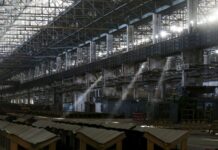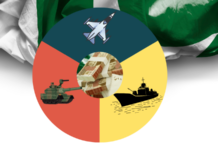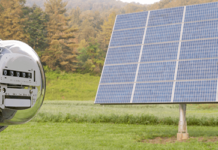–Govt to spend 17.7pc on defence-related activities in FY21
–Army to get 47.6pc of the total defence budget of Rs1.28tr
–Pakistan’s military expenditures on per capita basis are among lowest in the world; Israel spends $2,000 on a per capita basis while Pakistan spends $22
LAHORE: Amid Leading economists of Pakistan have pointed out a number of myths and facts about Pakistan’s defence budget.
Farrukh Saleem, an economist and financial analyst, said that the first myth is that the defence budget eats up the lion’s share of the country’s total budgetary expenses.
“In budget 2020-21, ‘Defence Affairs and Services’ has been allocated Rs1,289 billion out of the total budgetary expenses of Rs7,295 billion. What this means is that defence comprises 17.67 per cent of the total expenses and 82.33 per cent of all government expenses are non-defence related,” he explained.
Saleem said that the second myth is that of the total defence budget, Pakistan Army takes away the lion’s share. “Pakistan Army gets Rs613 billion (47.6 per cent), Pakistan Air Force Rs274 billion (21pc), Pakistan Navy Rs140 billion (11pc) and Inter-Services Intelligence Rs262 billion (20pc).”
He said that the third myth is Pakistan’s defence budget has been increasing at a high rate. In the 70s, he added, the allocation for defence amounted to 6.50pc of the gross domestic product (GDP).
He stated that in the financial year 2001-02, 20 years ago, the allocation for defence amounted 4.6pc of the GDP, whereas budget 2020-21 has allocated Rs1,289 billion which is 2.86pc of GDP.
In the 60s, Pakistan Army’s budget as a percentage of total expenditures hovered around 30pc. In budget 2020-21, Pakistan Army’s budget as a percentage of total expenditures has come down to 8pc.”
The fourth myth is that Pakistan has a large military, he said, adding that there are at least 64 countries in the world that have more military personnel on a per capita basis than does Pakistan.
These countries include Turkey, Iran, Iraq, Switzerland, Italy, Norway, Singapore, South Korea, Russia, Sri Lanka, Egypt, Libya, Kuwait, Thailand, Saudi Arabia, Qatar, UAE, Israel, Estonia, Vietnam, Slovenia, Botswana, Mongolia, Yemen, Kazakhstan, Cuba, Mauritania, Croatia, Chile, Somalia, Albania, Sao tome and Principe, Namibia, Angola, Cambodia, Uruguay, Bolivia, Romania, Morocco, Lithuania, Portugal, Burma, Algeria, Azerbaijan, Bhutan, Burundi, Bulgaria, Columbia, Serbia and Montenegro, Cyprus, Greece, Armenia, Djibouti, Maldives, Oman, Belarus, Jordan, Syria, Laos, Bahrain, Brunei, Eretria and North Korea.
Saleem pointed out the fifth myth is that Pakistan’s military expenditures are the highest in the world on a per capita basis.
“Pakistan’s military expenditures on a per capita basis are actually one of the lowest on the face of the plant. Israel spends $2,000 on a per capita basis and Pakistan spends $22 per capita.”
For him, the sixth myth is that the military’s commercial undertakings are a burden on the country’s economy.
“Fauji Fertilizer is one of the highest taxpayers in Pakistan. In 2019, Fauji Fertilizer paid Rs42 billion in taxes and duties. Fauji Cement deposits around Rs10 billion a year in the treasury on account of income taxes, excise duty and sales tax,” he said. “The fact is Pakistan spends 2.86pc of its GDP on defence, while the global average is 2.18pc. Yes, we do spend a higher percentage of our GDP on defence than the global average.”
He said the countries that spend even a higher percentage of their GDP on defence than Pakistan does include Saudi Arabia (8pc), Israel (5.3pc), Russia (3.9pc) and United States (3.4pc).
Saleem further stated, “It is also a fact that Pakistan Armed Forces are the sixth-largest in the world but our expenses on a per soldier basis are the lowest. The US spends $392,000 per soldier, Saudi Arabia $371,000, India $42,000, Iran $23,000 and Pakistan $12,500 per soldier.”
Agreeing with him, economic expert Dr Ikramul Haq said that his calculations are correct and depict a true picture.
“In the media, there is dissemination of misinformation about the budget allocations for defence and benefits available to them,” he said. “The biggest burden on the national exchequer is debt servicing that increased monstrosity due to wrong economic and fiscal policies of civilian regimes since 2008.”
Dr Haq shared that only about 10 per cent officers reach the rank of brigadier that is BPS-20 and when compared to the ratio of civil services, it is extremely low.
He added that only about 2 per cent officers become major generals and this average is further reduced for lieutenant generals.
The economic expert said that ratio of similar grade officers in civil services is much higher. He added that the allowances and benefits of legislators are much more as they enjoy free residences and vehicles, air tickets, etc.
“All armed officers pay their utility bills with no exception whatsoever but judges of higher courts get tax-free benefits of electricity and petrol, including tax-free cash judicial allowance,” Dr Haq pointed out.
He said that all officers of armed forces having taxable income pay income tax that is deducted at source for all ranks. If official residence is allotted, house rent is deducted from officers or all forces, he added.
He further said that Army Welfare Trust (AWT) as a commercial organisation is self-governing and generates funds through various businesses, and then deposits taxes in the government’s treasury.

























Would appreciate some answers for the following:
1. Are military pensions included in the defence budget?
2. Are tax exemptions (at taxpayer expense) provided to military backed organizations such as SCO, NLC, FWO, AWT etc?
3. Do the military backed organizations receive preference in government contracts?
4. Is the military allowed to use land alloted for defence needs to be repurposed for residential and commercial purposes?
1. pensions and procurement costs aren’t included. those cost extra
3. clearly they do.
i have answer for sleepless
1. i think pensions can not be excluded yo can not give that money under the table …
it is right for every one as when every other govt. servant. you know pension is not free money it is saving which a Govt. servant made during his work. and he don’t get much as average age of Pakistani men is just ~65
2. if SCO, NLC, FWO, AWT etc get tax exemption so does the WAPDA, PIA, and Universities or any Govt owned corporation or business. Govt can not tax himself … yes every one on salary have to pay Income Tax …
3. Do the military backed organizations receive preference in government contracts?
it may be possible if a Govet. owned or semi govt. owned corporation is in a bit for contract they would be preferred .. infect US army core of engineers did lots of civil constriction work in USA. You can find lots of examples elsewhere also
3. Do the military backed organizations receive preference in government contracts?
yap that is possibility and it is wrong but not so much so, as in Pakistan for every thing you need reference money and power …. we are in corruption from head to toes and no segment of society is immune to it …
4. have they sell there bases ? I don’t think so .. there wold be some commercial housing projects. but keep in mind not all. As bahria Towns and many like that are not at all owned by Military or any one from Military.
bye the way other Govt organizations also made colonies like WAPDA and Railway even police .. just WAPDA was most successful i had a plot there i sell early and cheep now i can’t buy again.
Ap na pension ke bat ke to pension ka leya hamasha alag budget allocation hote ha…
Civilian institute ke example la lo
For example education is second largest department after army last year education budget is almost equal to defence
last year values
Total Education: 947 Bn
Defence: 1152 Bn..
now en 2 department ke employ ke pension es ma add nahi ha pension ka leya alag budget allocate karte ha federal and provincial govt . bhi jan
Ap na pension ke bat ke to pension ka leya hamasha alag budget allocation hote ha…
Civilian institute ke example la lo
For example education is second largest department after army last year education budget is almost equal to defence
last year values
Total Education: 947 Bn
Defence: 1152 Bn..
now en 2 department ke employ ke pension es ma add nahi ha pension ka leya alag budget allocate karte ha federal and provincial govt . bhi jan
1. The defence budget quoted does not include pensions and procurement. Pensions come under a different head and procurement is kept secret.
2. Clearly army getting 47% of the defence budget means it’s getting the lion’s share. It’s getting more than twice what any other branch is getting
3. Comparing our per capita or per soldier defence expenses with developed countries makes no sense. Those countries can afford to spend that much. We can’t.
Seems like the whole analysis is designed to mislead with cherry picked statistics.
Aoa..in point 2 yiu said army getting lion’s share. And compared with other branch. Do you know the number of army air force and navy personnel?? Army is many a times bigger than navy and air force…if you see percentage wise then among armed forces , army is 60 percent of all the forces. So they should get 60percent of the total budget. What you say brother??
Umair Islam air force and navy needs more budget because their equipments are very expensive and need parts after a short period of time compared to land force equipment. Just check the price of 1 f16 and 1 jf17 then you will know about the difference between costs, same for navy.
Very good analysis! Anyone against it is a dickhead.
Good effort…
all good places are under whose control.
how much deposited from hana jheel, mangla dam etc as they are earning hell..
all mining etc done where is money..
I think its not lions share… If not a rupee is given from budget still… They will have enough… Roads made twice a year in army owned places whereas not in ten years in civil… This is difference.